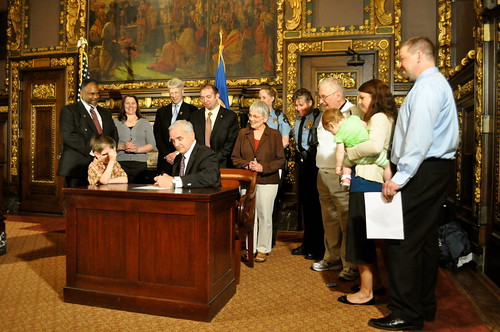 Remember that old rhyme from childhood, “First comes love, then comes marriage, then comes a baby in a baby carriage”? Some things are just part of life and are simply inevitable. People will fall in love. People will join together in relationships. These are all positive, great things. Unfortunately, people—whether gay or straight—all have struggles in life and relationships. Inevitably, when Minnesota granted same-sex couples the right to marry, it was inevitable that same-sex divorces would happen, just as opposite-sex divorces happen. Gay couples who married before marriage was legal in Minnesota—whether they became married in another state or, because Minnesota borders with Canada, often in another country—may now face the need to obtain a divorce. If a gay couple separates and does not intend to share their lives together going forward, they should strongly consider finalizing their separation by obtaining a legal divorce in Minnesota.
I have run into Minnesota gay couples who had no idea that they are now legally married. This viewpoint may be especially common for those couples who married in Canada years ago and then separated long before marriage was legal in Minnesota. For better or worse (pun intended), those couples continue to be married and need to divorce in order to clear up the division of their marital assets and debts. If they have children in common by adoption they need to determine their rights and responsibilities as to those children. Even if there is a non-joint child, which is common in same-sex marriages, the “non-parent” may be able to establish legally enforceable rights to visitation because of their significant connection with that child. Again, this is even though they are not legally “their” child. Because marriage creates an interest in real property (houses, etc.), the residence that the couple lived in or any other land and any mortgages (and any other debts) need to be addressed in the divorce.
Before same-sex marriage was legal in Minnesota, it was difficult for same-sex couples to form legally enforceable rights and responsibilities related to a committed relationship. Perhaps that is why some same-sex couples have a hard time believing that they now must use the legal system to fully end their marriage relationship.
By the way, I understand that Brangelina (Brad Pitt and Angelina Jolie, for those who don’t follow popular culture!) had declared they wouldn’t get married until same sex couples everywhere could get married…but apparently they couldn’t wait, because they were recently married. Well, my theory is that they had to wait until Minnesota made same-sex marriage legal (it just took a year to plan the wedding)!
Without getting divorced, a gay couple may find out later, to their surprise, that one of the pair is making a claim to part of the other’s retirement account or is holding up the sale or transfer of property that was owned during the marriage, because simply living separately doesn’t resolve all these issues. I expect that many same-sex couples will be unpleasantly surprised later in life that when they hear that they have to share their retirement with a partner from long ago that they never intended to share their retirement account with. Or, an inheritance may be held up–or never received as expected by a son or daughter–because of a claim for all or a share of the estate of a deceased same-sex spouse.
These are topics that are addressed well in the Collaborative Process because they can be approached from a perspective of respect and honoring of the love that the couple previously shared, while laying a foundation for future separate lives. Now that same-sex marriage is legal Minnesota, same-sex couples may likely find that the Collaborative Divorce process provides the proper legal, financial and other professional supports needed for disentangling the various legal rights and responsibilities incident to ending their legal marriage.
Remember that old rhyme from childhood, “First comes love, then comes marriage, then comes a baby in a baby carriage”? Some things are just part of life and are simply inevitable. People will fall in love. People will join together in relationships. These are all positive, great things. Unfortunately, people—whether gay or straight—all have struggles in life and relationships. Inevitably, when Minnesota granted same-sex couples the right to marry, it was inevitable that same-sex divorces would happen, just as opposite-sex divorces happen. Gay couples who married before marriage was legal in Minnesota—whether they became married in another state or, because Minnesota borders with Canada, often in another country—may now face the need to obtain a divorce. If a gay couple separates and does not intend to share their lives together going forward, they should strongly consider finalizing their separation by obtaining a legal divorce in Minnesota.
I have run into Minnesota gay couples who had no idea that they are now legally married. This viewpoint may be especially common for those couples who married in Canada years ago and then separated long before marriage was legal in Minnesota. For better or worse (pun intended), those couples continue to be married and need to divorce in order to clear up the division of their marital assets and debts. If they have children in common by adoption they need to determine their rights and responsibilities as to those children. Even if there is a non-joint child, which is common in same-sex marriages, the “non-parent” may be able to establish legally enforceable rights to visitation because of their significant connection with that child. Again, this is even though they are not legally “their” child. Because marriage creates an interest in real property (houses, etc.), the residence that the couple lived in or any other land and any mortgages (and any other debts) need to be addressed in the divorce.
Before same-sex marriage was legal in Minnesota, it was difficult for same-sex couples to form legally enforceable rights and responsibilities related to a committed relationship. Perhaps that is why some same-sex couples have a hard time believing that they now must use the legal system to fully end their marriage relationship.
By the way, I understand that Brangelina (Brad Pitt and Angelina Jolie, for those who don’t follow popular culture!) had declared they wouldn’t get married until same sex couples everywhere could get married…but apparently they couldn’t wait, because they were recently married. Well, my theory is that they had to wait until Minnesota made same-sex marriage legal (it just took a year to plan the wedding)!
Without getting divorced, a gay couple may find out later, to their surprise, that one of the pair is making a claim to part of the other’s retirement account or is holding up the sale or transfer of property that was owned during the marriage, because simply living separately doesn’t resolve all these issues. I expect that many same-sex couples will be unpleasantly surprised later in life that when they hear that they have to share their retirement with a partner from long ago that they never intended to share their retirement account with. Or, an inheritance may be held up–or never received as expected by a son or daughter–because of a claim for all or a share of the estate of a deceased same-sex spouse.
These are topics that are addressed well in the Collaborative Process because they can be approached from a perspective of respect and honoring of the love that the couple previously shared, while laying a foundation for future separate lives. Now that same-sex marriage is legal Minnesota, same-sex couples may likely find that the Collaborative Divorce process provides the proper legal, financial and other professional supports needed for disentangling the various legal rights and responsibilities incident to ending their legal marriage.  Remember that old rhyme from childhood, “First comes love, then comes marriage, then comes a baby in a baby carriage”? Some things are just part of life and are simply inevitable. People will fall in love. People will join together in relationships. These are all positive, great things. Unfortunately, people—whether gay or straight—all have struggles in life and relationships. Inevitably, when Minnesota granted same-sex couples the right to marry, it was inevitable that same-sex divorces would happen, just as opposite-sex divorces happen. Gay couples who married before marriage was legal in Minnesota—whether they became married in another state or, because Minnesota borders with Canada, often in another country—may now face the need to obtain a divorce. If a gay couple separates and does not intend to share their lives together going forward, they should strongly consider finalizing their separation by obtaining a legal divorce in Minnesota.
I have run into Minnesota gay couples who had no idea that they are now legally married. This viewpoint may be especially common for those couples who married in Canada years ago and then separated long before marriage was legal in Minnesota. For better or worse (pun intended), those couples continue to be married and need to divorce in order to clear up the division of their marital assets and debts. If they have children in common by adoption they need to determine their rights and responsibilities as to those children. Even if there is a non-joint child, which is common in same-sex marriages, the “non-parent” may be able to establish legally enforceable rights to visitation because of their significant connection with that child. Again, this is even though they are not legally “their” child. Because marriage creates an interest in real property (houses, etc.), the residence that the couple lived in or any other land and any mortgages (and any other debts) need to be addressed in the divorce.
Before same-sex marriage was legal in Minnesota, it was difficult for same-sex couples to form legally enforceable rights and responsibilities related to a committed relationship. Perhaps that is why some same-sex couples have a hard time believing that they now must use the legal system to fully end their marriage relationship.
By the way, I understand that Brangelina (Brad Pitt and Angelina Jolie, for those who don’t follow popular culture!) had declared they wouldn’t get married until same sex couples everywhere could get married…but apparently they couldn’t wait, because they were recently married. Well, my theory is that they had to wait until Minnesota made same-sex marriage legal (it just took a year to plan the wedding)!
Without getting divorced, a gay couple may find out later, to their surprise, that one of the pair is making a claim to part of the other’s retirement account or is holding up the sale or transfer of property that was owned during the marriage, because simply living separately doesn’t resolve all these issues. I expect that many same-sex couples will be unpleasantly surprised later in life that when they hear that they have to share their retirement with a partner from long ago that they never intended to share their retirement account with. Or, an inheritance may be held up–or never received as expected by a son or daughter–because of a claim for all or a share of the estate of a deceased same-sex spouse.
These are topics that are addressed well in the Collaborative Process because they can be approached from a perspective of respect and honoring of the love that the couple previously shared, while laying a foundation for future separate lives. Now that same-sex marriage is legal Minnesota, same-sex couples may likely find that the Collaborative Divorce process provides the proper legal, financial and other professional supports needed for disentangling the various legal rights and responsibilities incident to ending their legal marriage.
Remember that old rhyme from childhood, “First comes love, then comes marriage, then comes a baby in a baby carriage”? Some things are just part of life and are simply inevitable. People will fall in love. People will join together in relationships. These are all positive, great things. Unfortunately, people—whether gay or straight—all have struggles in life and relationships. Inevitably, when Minnesota granted same-sex couples the right to marry, it was inevitable that same-sex divorces would happen, just as opposite-sex divorces happen. Gay couples who married before marriage was legal in Minnesota—whether they became married in another state or, because Minnesota borders with Canada, often in another country—may now face the need to obtain a divorce. If a gay couple separates and does not intend to share their lives together going forward, they should strongly consider finalizing their separation by obtaining a legal divorce in Minnesota.
I have run into Minnesota gay couples who had no idea that they are now legally married. This viewpoint may be especially common for those couples who married in Canada years ago and then separated long before marriage was legal in Minnesota. For better or worse (pun intended), those couples continue to be married and need to divorce in order to clear up the division of their marital assets and debts. If they have children in common by adoption they need to determine their rights and responsibilities as to those children. Even if there is a non-joint child, which is common in same-sex marriages, the “non-parent” may be able to establish legally enforceable rights to visitation because of their significant connection with that child. Again, this is even though they are not legally “their” child. Because marriage creates an interest in real property (houses, etc.), the residence that the couple lived in or any other land and any mortgages (and any other debts) need to be addressed in the divorce.
Before same-sex marriage was legal in Minnesota, it was difficult for same-sex couples to form legally enforceable rights and responsibilities related to a committed relationship. Perhaps that is why some same-sex couples have a hard time believing that they now must use the legal system to fully end their marriage relationship.
By the way, I understand that Brangelina (Brad Pitt and Angelina Jolie, for those who don’t follow popular culture!) had declared they wouldn’t get married until same sex couples everywhere could get married…but apparently they couldn’t wait, because they were recently married. Well, my theory is that they had to wait until Minnesota made same-sex marriage legal (it just took a year to plan the wedding)!
Without getting divorced, a gay couple may find out later, to their surprise, that one of the pair is making a claim to part of the other’s retirement account or is holding up the sale or transfer of property that was owned during the marriage, because simply living separately doesn’t resolve all these issues. I expect that many same-sex couples will be unpleasantly surprised later in life that when they hear that they have to share their retirement with a partner from long ago that they never intended to share their retirement account with. Or, an inheritance may be held up–or never received as expected by a son or daughter–because of a claim for all or a share of the estate of a deceased same-sex spouse.
These are topics that are addressed well in the Collaborative Process because they can be approached from a perspective of respect and honoring of the love that the couple previously shared, while laying a foundation for future separate lives. Now that same-sex marriage is legal Minnesota, same-sex couples may likely find that the Collaborative Divorce process provides the proper legal, financial and other professional supports needed for disentangling the various legal rights and responsibilities incident to ending their legal marriage. 



